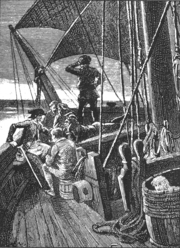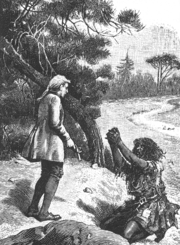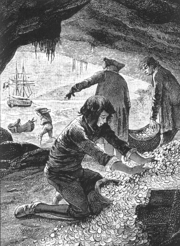Treasure Island
2008/9 Schools Wikipedia Selection. Related subjects: Novels
| Treasure Island | |
 Cover illustration by Frank Godwin (1925). |
|
| Author | Robert Louis Stevenson |
|---|---|
| Country | Scotland |
| Language | English |
| Genre(s) | Adventure |
| Publisher | Cassell & Company Ltd |
| Publication date | 1883 |
| Media type | Print ( Hardback & Paperback) |
| ISBN | NA |
Treasure Island is an adventure novel by Scottish author Robert Louis Stevenson, narrating a tale of "buccaneers and buried gold". First published as a book in 1883, it was originally serialised in the children's magazine Young Folks between 1881-82 under the title The Sea Cook, or Treasure Island.
Traditionally considered a coming of age story, it is an adventure tale known for its superb atmosphere, character and action, and also a wry commentary on the ambiguity of morality—as seen in Long John Silver—unusual for children's literature then and now. It is one of the most frequently dramatised of all novels. The influence of Treasure Island on popular perception of pirates is vast including treasure maps with an X, black schooners, tropical islands, and one-legged seamen with parrots on their shoulders.
History
Stevenson was 30 years old when he started to write Treasure Island, and it would be his first success as a novelist. The first fifteen chapters were written at Braemar in the Scottish Highlands in 1881. It was a cold and rainy August-September and Stevenson was with five family members on holiday in a cottage. Young Lloyd Osbourne, Stevenson's step-son, would pass the rainy days painting with water colors. Remembering the time, Lloyd wrote:
| “ | ..busy with a box of paints I happened to be tinting a map of an island I had drawn. Stevenson came in as I was finishing it, and with his affectionate interest in everything I was doing, leaned over my shoulder, and was soon elaborating the map and naming it. I shall never forget the thrill of Skeleton Island, Spyglass Hill, nor the heart-stirring climax of the three red crosses! And the greater climax still when he wrote down the words "Treasure Island" at the top right-hand corner! And he seemed to know so much about it too—the pirates, the buried treasure, the man who had been marooned on the island". "Oh, for a story about it", I exclaimed, in a heaven of enchantment, and somehow conscious of his own enthusiasm in the idea. | ” |
Within three days of drawing the map for Lloyd, Stevenson had written the first three chapters, reading each aloud to his family who added suggestions: Lloyd insisted there be no women in the story; Stevenson's father came up with the contents of Billy Bones' sea-chest, and suggested the scene where Jim Hawkins hides in the apple barrel. Two weeks later a friend, Dr. Alexander Japp, brought the early chapters to the editor of Young Folks magazine who agreed to publish each chapter weekly.
As autumn came to Scotland, the Stevensons left their summer holiday retreat for London, but Stevenson was troubled with a life-long chronic bronchial condition that put an end to his work on the novel at about chapter fifteen. Concerned about a deadline they traveled in October to Davos, Switzerland where the clean mountain air did him wonders and he was able to continue, and, at a chapter a day, soon finished the story.
During its initial run in Young Folks from October 1881 to January 1882 it failed to attract any attention or even increase the sales of the magazine. But when sold as a book in 1883 it soon became very popular. Prime Minister of the United Kingdom William Ewart Gladstone was reported to have stayed up until two in the morning to finish it. Critics widely praised it. American novelist Henry James praised it as "..perfect as a well-played boys game". Gerard Manley Hopkins wrote "I think Stevenson shows more genius in a page than Sir Walter Scott in a volume".
"The effect of Treasure Island on our perception of pirates cannot be overestimated. Stevenson linked pirates forever with maps, black schooners, tropical islands, and one-legged seamen with parrots on their shoulders. The treasure map with an X marking the location of the buried treasure is one of the most familiar pirate props", yet it is entirely a fictional invention which owes its origin to Stevenson's original map. The term "Treasure Island" has passed into the language as a common phrase, and is often used as a title for games, rides, places, etc.
Thanks to Stevenson's letters and essays, we know a lot about his sources and inspirations. The initial catalyst was the treasure map, but he also drew from memories of works by Daniel Defoe, Edgar Allan Poe and Washington Irving. Stevenson says that the novel At Last by Charles Kingsley was a key inspiration. The idea for the character of Long John Silver was inspired by his real-life friend William Henley, a writer and editor, who had lost his lower leg to tuberculosis of the bone. Lloyd Osbourne described him as "..a great, glowing, massive-shouldered fellow with a big red beard and a crutch; jovial, astoundingly clever, and with a laugh that rolled like music; he had an unimaginable fire and vitality; he swept one off one's feet". In a letter to Henley after the publication of Treasure Island Stevenson wrote "I will now make a confession. It was the sight of your maimed strength and masterfulness that begot Long John Silver...the idea of the maimed man [ed. Henley was crippled], ruling and dreaded by the sound [ed. voice alone], was entirely taken from you". Other books which resemble Treasure Island include Robert Michael Ballantyne's Coral Island (1871), Captain Marryat's The Pirate (1836). H. Rider Haggard's King Solomon's Mines (1885), the first of the " Lost World" literary genre, was the product of a bet between Rider Haggard and his brother that he could write a better novel than Treasure Island.
Stevenson had never encountered any real pirates in his life. However his descriptions of sailing and seamen and sea life are very convincing. His father and grandfather were both lighthouse engineers and frequently voyaged around Scotland inspecting lighthouses, taking the young Robert along. Two years before writing Treasure Island he had crossed the Atlantic Ocean. So authentic were his descriptions that in 1890 William Butler Yeats told Stevenson that Treasure Island was the only book from which his seafaring grandfather had ever taken any pleasure.
Critically, the novel can be seen as a bildungsroman, dealing, as it does, with the development and coming of age of its narrator, Jim Hawkins.
Stevenson was paid 34 pounds seven shillings and sixpence for the serialization and 100 pounds for the book.
Plot summary
Template:Spoiler Jim Hawkins is a young boy who lives at his parents’ sleepy sea-side inn, the Admiral Benbow, near Bristol, England, in the mid-18th century. One day, an old and menacing sea captain referred to as Billy Bones appears and takes a room at the inn. The captain paying "three or four gold pieces" in advance stays for "month after month, so that all the money had been long exhausted". One day, an equally menacing figure named Black Dog arrives at the Inn looking for Bill, and when the two pirates meet, Jim overhears them arguing in the parlor and finally the two begin fighting. Billy wounds Black Dog, but immediately afterwards falls to the ground from a stroke. Bill tells Jim that Black Dog was "a bad 'un" and "mind you, it's my sea chest they're after". He mutters incoherently to Jim about a man named Captain Flint and something he was given the day Flint died at Savannah. Jim's father soon dies, and the day after his funeral a blind pirate appears at the inn where he presents the captain with " The Black Spot", a secret pirate message which officially pronounced a verdict of guilt and promised a death sentence for the recipient. The captain shortly dies of a stroke at the inn. Hastily, Jim and his mother unlock Billy’s sea chest (under pretense of payment for his inn tab), finding an account book and map inside. Hearing steps outside, they quickly leave with the documents before Billy’s pursuers ransack the inn looking for the same. Luckily, Jim and his Mother had informed the local hamlet of the threat to the inn. Soon four or five riders arrive, and the blind pirate, Pew, is crushed beneath a horse's hooves. Most of the other pirates escape in a lugger.
Jim realizes that the contents he has snatched from the sea chest must be valuable, so he takes the documents he has found to some local aristocratic acquaintances, Dr. Livesey and Squire John Trelawney. Excited, they recognize it as a map leading to the fabled treasure Captain Flint buried on Skeleton Island in the West Indies. Trelawney immediately starts planning an expedition. Naïve in his negotiations to outfit his ship, the Hispaniola, Trelawney is tricked into hiring one of Flint’s former mates, Long John Silver as a cook, as well as many of Flint’s old crew. Only the captain, Smollett, is trustworthy, but Trelawney has fallen under the charismatic spell of Silver and believes him to be the better man. The ship sets sail for Skeleton Island with nothing amiss, until Jim overhears Silver’s plans for mutiny. Jim tells the captain about Silver and the rest of the rebellious crew. Captain Smollett is vindicated in the eyes of the others and becomes the leader of the "faithful crew".
Landing at the island, Captain Smollett devises a plan to get most of the mutineers off the ship, allowing them leisure time on shore. Without telling his companions, Jim sneaks into the pirates’ boat and goes ashore with them. Frightened of the pirates, Jim runs off alone into the forest. From a hiding place, he witnesses Silver’s murder of a sailor who refuses to join the mutiny. Jim flees deeper into the heart of the island, where he encounters a half-crazed man named Ben Gunn. Ben had once served in Flint’s crew but was marooned alone on the island three years earlier.
Meanwhile, Smollett and his men have gone ashore and taken shelter in a stockade they found which Flint had built years earlier. Jim returns to the stockade and tells of his encounter with Ben. Silver visits under a white flag of truce and attempts a negotiation with the captain, but Smollett deliberately goads him into a shouting match, knowing that a pirate attack is likely sooner or later and that it may as well be sooner, while it is expected. The pirates attack the stockade within the hour, and are driven off with serious losses, but the captain is wounded. Eager to take action, Jim follows another whim and deserts his companions, sneaking off to hunt for Ben’s handmade coracle hidden in the woods.
After finding Ben’s boat, Jim sails out to the anchored ship with the intention of cutting it adrift, thereby depriving the pirates of a means of escape. He cuts the rope, but he realizes his small boat has drifted near the pirates’ camp and fears he will be discovered. By chance, the pirates do not spot Jim, and he floats around the island until he catches sight of the ship drifting wildly. Struggling aboard, he discovers that one of the two watchmen left aboard, Israel Hands, has killed the other watchman in a drunken fit and is seriously injured himself. Jim takes control of the ship, but Israel turns against him in a fight in the rigging. Jim is wounded but kills Israel.
Jim returns to the stockade at night not realizing it has since been occupied by the pirates. Silver takes Jim hostage, telling the boy that the captain has given the pirates the treasure map, provisions, and the use of the stockade in exchange for their lives. Silver is having trouble managing his men, who accuse him of treachery. Silver proposes to Jim that they help each other survive by pretending Jim is a hostage. However, the men present Silver with a black spot and inform him that he has been deposed as their commander. In a skilled attempt to gain control of his crew, Silver slyly shows them the treasure map to appease them, narrowly saving Jim's life (and Silver's) from the fickle pirates. Silver is unanimously re-elected as captain, to cries of "Silver!" and "Barbecue forever! Barbecue for cap'n!"
The next day Silver leads Jim and the last five pirates to the treasure site, but they are shocked to find it already excavated and the treasure removed except for a few stray coins. The pirates are angered and ready to kill Silver and Jim once and for all. At that moment Dr. Livesey, Squire Trelawney, Ben Gunn, and the others appear from the bushes and fire on the pirate band, killing two and scattering three others throughout the island. Silver at this point has switched sides yet again, and because he saved Jim's life earlier, is accepted warily back into the group.
After spending three days carrying the loot from Ben's cave to the ship, the men prepare to set sail for home. There is a debate about the fate of the remaining mutineers. Despite the three pirates’ pleas, they are left marooned on the island, perhaps a kinder fate than returning them home to the gibbet, and much to the glee of Ben Gunn. Silver is allowed to join the voyage to a nearby Spanish American port, where he sneaks off the ship one night with the help of Ben Gunn carrying a small portion of the treasure and is never heard of again. The voyage home is uneventful.
Squire Trelawney and Doctor Livesey resume their business as usual, despite being thousands of pounds richer. Captain Smollett retires from the sea on his share and lives peacefully in the country. Ben Gunn spends all of his money within nineteen days and soon falls back upon begging. However, he is given a small pension by the Squire.
Jim Hawkins is able to run the Admiral Benbow on his own, but suffers in a deeper way from his time on the island. "The bar silver and the arms still lie, for all that I know, where Flint buried them ... [but] oxen and wain-ropes would not bring me back again to that accursed island; and the worst dreams that ever I have are when I hear the surf booming about its coasts or start upright in bed with the sharp voice of Captain Flint [Silver's talking parrot] still ringing in my ears: ' Pieces of eight! Pieces of eight!'"
Template:End spoiler
Main characters
- Jim Hawkins: the young man who finds the treasure map and for most of the story the narrator
- Billy Bones: a pirate who has the map of Flint's Fist. Dies of a stroke brought on by the Black Spot
- Squire John Trelawney: a skilled marksman, he is naïve and hires the crew almost entirely on Long John Silver's advice
- Dr. Livesey: a doctor and friend of Trelawney who goes on the journey and for a short while narrates the story
- Captain Alexander Smollet: the stubborn captain of the Hispaniola
- Long John Silver: a one-legged pirate
- Israel Hands: a pirate who is killed when he falls from a mast
- Ben Gunn: an insane and marooned pirate
- Pew: a blind pirate that is killed when he is trampled by horses
- Captain Flint: a feared pirate captain who dies in Savannah; also Long John's parrot's name.
Adaptations
Film and TV
There have been over 50 movie and TV versions made. Some of the notable ones include:
Film
- 1920- silent version starring Shirley Mason.
- 1934- Treasure Island- starring Jackie Cooper, Wallace Beery. An MGM production, the first sound film version.
- 1950- Treasure Island- starring Bobby Driscoll, Robert Newton. Notable for being Disney's first completely live action film. A sequel to this version was made in 1954, called Long John Silver.
- 1971- Animal Treasure Island. An anime film directed by Hiroshi Ikeda and written by Takeshi Iijima and Hiroshi Ikeda with story consultation by famous animator Hayao Miyazaki. This version replaced several of the human characters with animal counterparts.
- 1972- Treasure Island- starring Orson Welles.
- 1996- Muppet Treasure Island.
- 1999- Treasure Island- starring Kevin Zegers, Jack Palance
- 2002- Treasure Planet. Disney animated version set in space, with Long John Silver as a cyborg.
- 2007- L'Île aux Trésors. A loosely adapted version, in French, starring French actors, of the original novel.
TV
- 1990- Treasure Island- starring Christian Bale, Charlton Heston and Pete Postlethwaite. A made for TV film written, produced and directed by Heston's son, Fraser C. Heston.
- 1993- The Legends of Treasure Island. An animated series loosely based on the novel, with the characters as animals.
There are also a number of Return to Treasure Island sequels produced:a 1986 Disney mini-series, a 1992 animation version, and a 1996 and 1998 TV version.
Theatre and radio
There have been over 24 major stage and radio adaptations made. The number of minor adaptations remains countless.
- Orson Welles broadcast a radio adaptation via Mercury Theatre on July 1938; half in England, half on the Island; omits "My Sea Adventure"; music by Bernard Herrmann; Available online.
- In 1947, a production was mounted at the St. James's Theatre in London, starring Harry Welchman as Long John Silver and John Clark as Jim Hawkins.
- For a time, in London there was an annual production at the Mermaid Theatre, originally under the direction of Bernard Miles, who played Long John Silver, a part he also played in a television version. The late comedian Spike Milligan would often play Ben Gunn in these productions.



